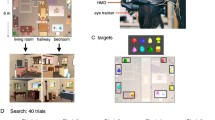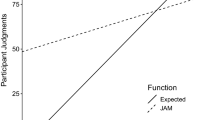Abstract
This paper is concerned with the use of virtual environments as a means of conveying semantic information relating to the contents of computerised textual databases. two empirical studies are reported that investigated the influence of individual differences in cognitive ability on search task performance. In the first experiment, objects (each representing a type of animal) were placed ordinally in a three-dimensional cube arrangement based on ratings of semantic similarity. Participants were required to locate a series of randomly selected objects. Contrary to prediction, participants with high associative memory were comparatively poorer performers. In a second experiment ‘true’ rating distances were used to locate objects in virtual space. High spatial ability was associated with better performance and, in contrast with the results of Experiment 1, this pattern also was replicated for associative memory. Implications are discussed.
Similar content being viewed by others
References
Fischer G, Stevens C. Information access in complex, poorly structured information space. In: Proceedings of CHI '91 ; 63–70
Furnas GW. Navigation-by-query, query-by-navigation, and other tricks to try. In: Browsing vs. search: can we find a synergy. Panel (Mackinlay et al, eds), Proceedings of CHI '95; 180
Mukherjea S, Foley JD. Showing the context of nodes in the World Wide Web. In: Proceedings of CHI '95; 326–327
Chalmers M, Chiston P. Bead: explorations in information visualisation. In: Proceedings of SIGIR. London: Springer, 1992; 330–337
Chen C. Bridging the gap: the use of pathfinder networks in visual navigation. Journal of Visual Language and Computing 1988; 9: 267–286
Krohn U. Visualization of navigational retrieval in virtual information spaces. In: Proceedings of the Workshop on New Paradigms in Information Visualization and Manipulation. Baltimore, MD, 2 December 1995; 26–32
Mariani JA, Lougher R. Triplespace: an experiment in a 3D graphical interface to a binary relational database. Interacting with Computers 1992; 4: 147–162
Dillon A, McKnight C, Richardson J. Navigation in hypertext: a critical review of the concept. In: Proceedings of INTERACT '90. Amsterdam: North Holland 1990; 587–592
Tolman EC. Cognitive maps in rats and men. Psychological Review 1948; 55: 189–208
Chen C, Czerwinski M. Spatial ability and visual navigation: an empirical study. The New Review for Hypertext and Multimedia 1997; 3: 40–66
Westerman SJ, Cribbin T. Mapping semantic information in virtual space: dimensions, variance, and individual differences. International Journal of Human-Computer Studies, in press
Egan DE. Individual differences in human-computer interaction. In: Handbook of human-computer interaction. Hellander M, ed. Elsevier Science: North Holland; 543–569
Westerman SJ. Individual differences in human-computer interaction. Unpublished PhD Dissertation. Birmingham: Aston University, 1993
Carroll JB. Human cognitive abilities: a survey of factor analytic studies. Cambridge University Press, 1993
Campagnoni FR, Erlich K. Information retrieval using a hypertext-based help system. ACM Transactions on Information Systems 1989; 7: 271–291
Vicente KJ, Hayes BC, Williges RC. Assaying and isolating individual differences in searching a hierarchical file system. Human Factors 1987; 29; 349–359
Westerman SJ. A comparison of the cognitive demands of navigating two- vs three-dimensional spatial database layouts. Ergonomics 1998; 41: 207–216
Chen C. Individual differences in a spatial-semantic virtual environment. Journal of the American Society for Information Science 2000; 51: 529–542
Battig WF, Montague WE. Category norms for verbal items in 56 categories. Journal of Experimental Psychology Monograph 1969: 80: 1–46
Westerman SJ, CRibbin T. Navigating virtual information spaces: individual differences in cognitive maps. In: Proceedings of UK Virtual Reality Special Interest Group. Manchester, 1999; 95–105
Smith P. Towards a practical measure of hypertext usability. Interacting with Computers 1996; 8: 365–381
Vidulich MA, Tsang PS. Collecting NASA workload ratings: a paper and pencil package. Working Paper. Moffett Field, CA: NASA Ames Research Center, 1986
Ekstrom RB, French JW, Harman HH. Manual for kit of factor-referenced cognitive tests. Princeton, NJ: Educational Testing Service, 1976
Author information
Authors and Affiliations
Corresponding author
Rights and permissions
About this article
Cite this article
Westerman, S.J., Cribbin, T. Cognitive ability and information retrieval: When less is more. Virtual Reality 5, 1–7 (2000). https://doi.org/10.1007/BF01418971
Issue Date:
DOI: https://doi.org/10.1007/BF01418971




